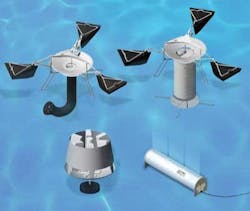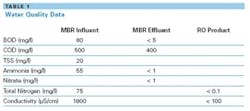MBR Provides Effective Pretreatment for RO Systems
By John Koch and Antonia von Gottberg
[Web Exclusive - Industrial WaterWorld - Sept. 1, 2009] -- Reusing treated wastewater for beneficial purposes, such as agricultural and landscape irrigation, industrial processes, toilet flushing or groundwater basin replenishment, is growing in response to environmental and economic concerns.A key factors involved in recycling wastewater treatment plant (WWTP) effluent for another use is the need to reduce total dissolved solids (TDS). This is often done by using a reverse osmosis (RO) system, which relies on pressure differential to force a solution (in this case, water) through a membrane that retains the solute on one side and allows the pure solvent to pass to the other side.While extremely effective on biologically treated wastewater, RO systems need to be coupled with an effective pretreatment system to avoid common issues that can result in system failure, including plugging, fouling and scaling. A pretreatment option for wastewater applications is membrane bioreactor (MBR) technology, in which a membrane process like ultrafiltration (UF) or microfiltration is combined with a suspended growth bioreactor. MBR provides high quality feed water to the RO, minimizes footprint and the cost of civil works, and reduces treatment plant downtime, thereby reducing operating costs.
Koch Membrane Systems' PURON® submerged MBR technology has successfully been used as the pretreatment option for challenging industrial and municipal water reuse RO systems, and can help make water recycling technologies more cost-effective.
RO a Challenge for Reuse
Pretreatment methods are critical when designing RO systems. For example, RO membranes used for most water reuse applications contain a brine spacer, typically made of low density polyethylene mesh netting. If there's a high level of suspended solids in the feed water, this brine spacer can become plugged.
Another issue is the high levels of organics contained in many biologically treated wastewaters, which are rejected by the RO membrane and progressively concentrated as the water flows across the membranes. This concentration of organics can foul the membrane, especially towards the RO system outlet. Biofouling can also occur, because the organics in wastewater make an excellent food source for microorganisms. And some treated wastewaters contain high levels of bacteria, so biogrowth may occur quickly even if RO feed water is disinfected.
Finally, calcium phosphate scaling can cause problems with RO systems operating on some wastewaters. This scaling can be mitigated by operating at lower water recovery, using acid or other antiscalant to minimize scaling, or modifying the operating conditions of the WWTP to reduce the amount of phosphate in the RO feed.
These plugging, fouling and scaling issues mean the RO system needs to be operated at higher pressures, leading to increased power consumption, higher chemical costs for cleaning, and a shorter membrane life.
How can these challenges be minimized and overall water reuse system lifecycle costs reduced? Effective pretreatment of the feed water before it flows through the RO system is the answer, provided the pretreatment steps are chosen carefully to ensure the RO system can work as intended.
Figure 2. PURON® UF Module for MBR
RO Pretreatment Options
There are many different pretreatment options, and the best for a particular process depends on power, chemical, labor and land costs, wastewater source, and the existing wastewater treatment system.
Conventional pretreatment --The conventional effluent pretreatment scheme might be primary treatment, biological treatment and, the most crucial part of the process, solids-liquid separation using secondary clarification. A conventional sedimentation process often doesn't remove enough bacteria and suspended solids, so sand filtration may be added to improve solids-liquid separation and provide higher quality water to feed the RO system. Using ferric chloride along with sand filtration may enhance solids and organics removal. Upsets in the secondary clarifier, however, can lead to effluent with higher levels of TSS and BOD, causing plugging of the brine spacer with suspended solids and organic fouling. Power consumption for RO systems with this type of pretreatment tends to be high, and membrane life is often quite short.
Lime softening has been somewhat more successful in protecting the RO membranes, but this increases operating costs and doesn't totally prevent RO membrane fouling.
UF improves TSS removal -- Many of today's water reuse systems use an ultrafiltration (UF) pretreatment step to remove suspended solids. These systems typically use hollow fiber UF membranes, which do an excellent job of providing water with low suspended solids to feed the RO system. Still, the UF system is an extra treatment step, requiring additional footprint and adding to operating costs. The UF system may also be susceptible to upsets from a conventional WWTP, which can further increase its operating costs.
MBR as RO pretreatment -- With an MBR, the UF membranes are submerged in the activated sludge to combine the biological step and solid-liquid separation into a single process. The membrane acts as a barrier, which improves the effluent quality. The MBR eliminates the secondary clarifier and doesn't rely on gravity for liquid-solids separation, which allows the activated sludge to operate with a higher mixed liquor suspended solids (MLSS) concentration. An increased MLSS concentration reduces bioreactor tank volume, saving footprint and capital construction costs. Overall, the MBR process reduces footprint significantly compared to the combination of conventional activated sludge followed by sand filtration or UF. The footprint savings due to the wastewater treatment plant alone can be as much as 50%, along with additional footprint savings from eliminating other filtration steps.
Using MBR technology also simplifies the overall treatment train, minimizing the number of unit operations.
Floating Fiber MBR design
The PURON submerged hollow fiber UF module offers robust, cost effective solutions for RO pretreatment. The patented membrane module contains hollow fibers, the lower ends of which are fixed in a header. The upper ends are individually sealed and are free to move laterally, as shown in Figure 1. This module is submerged in the mixed liquor. All solids and particulates remain on the outside of the fibers, while permeate flows in an outside-in pattern by means of a vacuum that evacuates permeate through the inside of the hollow fiber.
The free moving fibers, combined with central air scour aeration, ensure stable filtration during plant operation, long membrane life, and lower operating costs due to reduced need for energy, cleaning and maintenance.
MBR for Industrial Processes
This floating hollow fiber MBR design has been used as pretreatment for a number of challenging industrial wastewater systems. For example, a Belgian firm that manufactures chemicals for film processing and printing uses large amounts of fresh water for cleaning and production. The firm began reusing its wastewater to reduce its fresh water costs, and selected an RO system to produce water with the low salt and nitrogen content required for its process. It installed a PURON submerged hollow fiber MBR as the pretreatment step prior to the RO, and the system has been operating successfully since 2005.
Another example is an Australian malt-producing company that sought to reduce its use of freshwater by recycling its wastewater. PURON MBR technology was chosen as the pretreatment step for the RO system, since it provided the best quality water to feed the RO while minimizing overall operating costs. The MegaMagnum® RO system recovers the MBR effluent as product water for reuse. The system has been running since 2006. In fact, the RO permeate quality is equal to or better than the local potable water supply.
Space and Cost Issues
Treatment operation footprint is a primary consideration in developing the best treatment system. Since the PURON MBR system reduces the volume of the bioreactor tanks and eliminates the secondary clarifier, the footprint for an MBR process is much smaller than tertiary filtration steps with sand filtration or UF. If space is limited, MBR may be the only pretreatment choice that fits in the available space.
Other considerations include costs of land, civil works, equipment, power, chemicals and labor, and the payback period used. High land and civil costs tend to favor MBR use. For large municipal treatment facilities requiring RO as a final treatment step, an MBR should compare favorably to conventional wastewater treatment as a pretreatment step prior to RO. In a 20-year analysis, the municipality should realize savings in RO membrane replacement and power as a result of the MBR pretreatment step. For an industrial company looking at a short payback, the preference for conventional or MBR technology will depend on the relative cost of civil works and land vs. equipment cost.
Conclusions
Using RO systems to reclaim and recycle wastewater effluent is growing rapidly, and Koch Membrane System's PURON MBR technology is now being considered as the pretreatment option for an increasing number of industrial and municipal reuse applications. These submerged membrane modules provide high quality feed water to the RO, minimize footprint and the cost of civil works, and reduce the susceptibility of the RO treatment train to upsets. IWW
About the Authors: John Koch is Water & Wastewater Systems director at Koch Membrane Systems, which is based in Wilmington, MA. Formerly KMS director of municipal water technology, Antonia von Gottberg is a consultant in Cambridge, MA. Contact: 888-677-5624, [email protected] and www.kochmembrane.com
###



